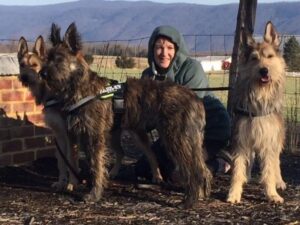
Michele Fitzgerald | Flywire Berger Picards
Berger Picard breeder Michele Fitzgerald discusses breed history, breeding practices, and community involvement in the USA.

Home » Dog Breeds » Berger Picard Dog Breed
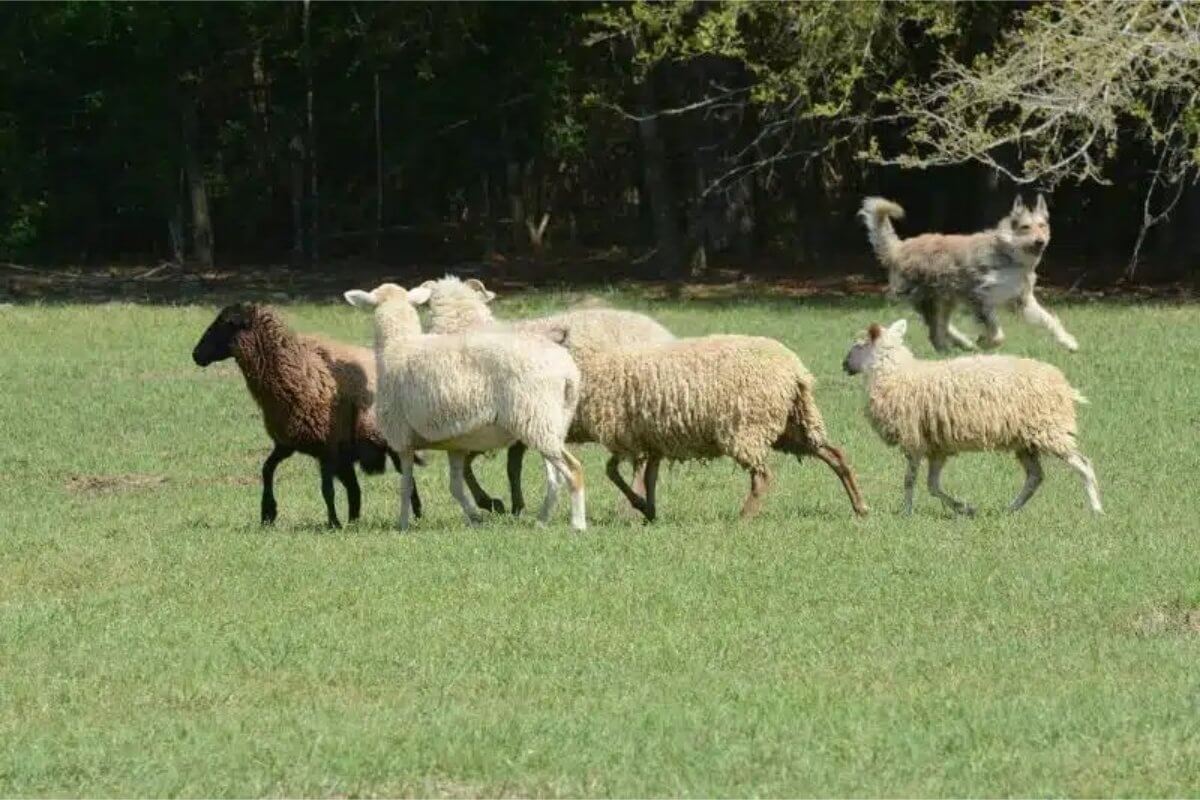
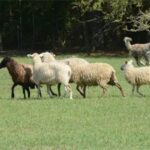
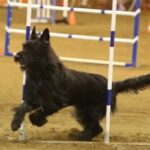
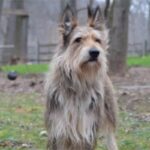
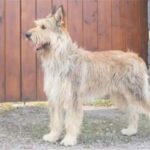
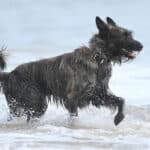
The Berger Picard, also known as the Picardy Shepherd, or more simply, the Picard, is a rare and ancient French herding dog known for its energetic spirit and striking appearance. This breed exudes confidence and intelligence while maintaining an unmistakably rustic charm. The breed’s alertness and steadfast loyalty make these shaggy shepherds not only excellent working dogs but also devoted companions.
Herding
21.5 – 25.5 Inches
50 – 70 Pounds
12 – 13 Years
| Country of Origin | France |
|---|---|
| Bred For | Herding, Working, Companionship |
| Known For | Scruffy Appearance, Distinctive Erect Ears, Confidence, Observant |
| Popularity | Low |
| Temperament | Alert, Good-Natured, Loyal, Observant |
| Activities | Herding, Running, Hiking, Farm Dog, Conformation Shows, Dog Sports |
The Berger Picard, affectionately known by some as the Picardy Shepherd, stands as one of the oldest French herding breeds, with a rich heritage deeply rooted in the Picardy region of Northern France. The breed’s lineage is believed to have originated from the herding dogs brought to Europe by the Celts during their migrations. Through the subsequent centuries, the ancient dogs intermingled with local canines, gradually evolving into the distinct Berger Picard that is recognized today.
Historically, the Picard’s primary role was herding livestock, especially sheep, in the French fields. The dog’s agile build, combined with its sharp intellect, made it an invaluable worker. Moreover, its tenacity, loyalty, and keen alertness rendered it an excellent watchdog, safeguarding farms and families without reservation.
The Berger Picard faced significant challenges during the 20th century. The two World Wars, which caused many battles to be fought in the regions where the Picard was most popular, led to a drastic decline in its numbers. The melees nearly resulted in the breed’s extinction. Following the Second World War, dedicated breed enthusiasts began a concerted effort to revive the breed. Despite these efforts, however, the Picard remained relatively unknown outside its native region for a long time.
On the global stage, the Berger Picard gained recognition from several notable kennel clubs. The Fédération Cynologique Internationale, an international canine organization, has long championed the breed, and The Royal Kennel Club in the United Kingdom has also recognized it, further enhancing its status on an international scale. The American Kennel Club officially acknowledged the breed only in 2015, boosting its popularity in the United States.
Today, the Berger Picard’s challenging past stands as a testament to its resilience. The breed, once on the brink of extinction, has not only survived but thrived, endearing itself to dog enthusiasts in many parts of the world. Whether on the farm as a working dog or in the home as a loyal companion, the Picard continues to capture hearts with its unique charm and rich history.
Adult male Berger Picards typically stand between 23.5 and 25.5 inches tall at the shoulder, while mature females generally have a height range from 21.5 to 23.5 inches.
As for weight, adult Picards usually weigh between 50 and 70 pounds.
The Berger Picard exhibits a balanced build, with its body being slightly longer than the height at the withers, which is especially noticeable in females. The distance from the withers to the elbow equals that from the elbow to the ground. The Picard’s sturdy bone and well-defined musculature are tailored for endurance work, helping these dogs move with ease and efficiency. This build not only speaks to the breed’s agility and stamina in the field but also of its history as a diligent herder.
Texture: The coat of the Berger Picard consists of a soft, short, and dense undercoat and a rough, shaggy outer coat that presents an unkempt appearance with a harsh and crisp texture. It is medium in length and provides ample protection in various weather conditions. A moderate beard and moustache, rough eyebrows, and a ruff on the front and sides of the neck create a distinctive look called “griffonage.” Although the coat is distinctive, it must never appear overly refined or manicured.
| Standard Color | |
|---|---|
| Fawn | ee |
| Brindle | ee |
| Standard Marking | |
|---|---|
| White Markings | ee |
| Brindle | ee |
A Note About Color: The Berger Picard may be fawn or brindle in color. Fawn-colored dogs may be clear or have dark trim on the ears and a gray underlay on the head and body known as “charbonné.” A brindle coat can have a base color from black to light gray to fawn, with brindling that is black, brown, red, gray, or fawn. A small white patch on the chest or on the tips of the toes is acceptable. Solid black dogs or white, pied, spotted, or harlequin dogs are not acceptable in the breed.
The Berger Picard’s tail is strong at the base and tapers towards the tip. When at rest, it hangs down and reaches the hocks. In action or when the dog is excited, the tail can be slightly curved, but it should never curl over the back. Instead, it moves in harmony with the dog’s gait, reflecting the Picard’s mood and energy. The tail is left natural and is never docked. Its tip ends in a slight crook or “J” shape, never leaning to the right or left..
The Berger Picard is a lively and intelligent breed, bringing both joy and challenges to its caretaker. Its loyalty and affection make these dogs endearing companions, but potential owners must be prepared for their energetic and sometimes stubborn nature.
Berger Picards are generally hearty dogs owing to their history as hard-working herders. However, like all breeds and mixed breeds, they can be susceptible to certain health-related conditions. Regular veterinary check-ups, a balanced diet, and adequate exercise can help these aloof and lively dogs lead long and healthy lives.
Lifespan: A Berger Picard typically has a lifespan of 12 to 13 years. Proper care, regular veterinary check-ups, and a loving environment can support the likelihood of an even longer life.
While the Berger Picard is known for its hardiness, there are certain conditions to which the breed can be predisposed:
Regular veterinary visits can help in the early detection and management of these and other potential health issues. It’s also beneficial for Berger Picard owners to be aware of any genetic testing or health screenings recommended for the breed and to consultant with breeders about the current protocols for testing.
The personality of the Berger Picard is as distinctive as their appearance. Known for their intelligence and spirited nature, these dogs exhibit a remarkable balance of independence and affection. They form deep bonds with their families, showing a level of loyalty and devotion that makes them excellent companions. However, their independent streak means they may not always seek constant attention, embodying a confident and self-assured demeanor.
Berger Picards are generally good with children, displaying a patient and protective attitude. Their herding instincts, though, can sometimes lead to a tendency to herd smaller children, which should be monitored. When it comes to other dogs and pets, the Berger Picard is usually friendly, although early socialization is key to develop this trait. They can be reserved around strangers, not showing immediate warmth, but are not typically aggressive.
For novice owners, the Berger Picard can be a challenge due to their strong-willed nature. They respond best to consistent, positive reinforcement training methods. These dogs are sensitive and can react to the tone of voice and mood of their human companions, making a calm and assertive approach in training most effective.
Regarding being alone, the Berger Picard can tolerate some alone time but thrives on companionship and activity. Prolonged periods of solitude can lead to boredom and potential behavior issues. Engaging them in activities and providing sufficient mental and physical stimulation is crucial for their well-being.
Feeding and nutrition are crucial aspects of caring for a Berger Picard, a breed known for its energy and vitality. The dietary needs of a Berger Picard vary at different stages of their life, from puppyhood to adulthood. As puppies, they require a diet rich in proteins and fats to support their rapid growth and development. High-quality puppy food, specifically formulated for medium to large breeds, is ideal to make sure that they receive the right balance of nutrients.
As they transition to adulthood, the dietary focus shifts to maintaining their health and energy levels. Adult Berger Picards typically do well on a balanced diet of high-quality adult dog food. The amount of food a Berger Picard requires can depend on their age, size, activity level, and metabolism. On average, an adult Berger Picard might consume 2 to 3 cups of dry dog food per day, divided into two meals. However, this can vary, and it’s essential to monitor their weight and adjust food portions accordingly to avoid overfeeding.
Regular feeding schedules and controlled portion sizes are important to prevent obesity, a condition that can lead to health issues in the breed. Fresh water should always be available, and treats should be given in moderation.
Consultation with a veterinarian can provide tailored nutritional advice, especially considering that individual dogs may have specific dietary needs or sensitivities. Regular check-ups can help your Berger Picard maintain an optimal weight and receive the necessary nutrients for a healthy, active life.
Training a Berger Picard requires patience, consistency, and an understanding of their intelligent and somewhat independent nature. This breed, known for its quick learning ability, responds well to positive reinforcement techniques such as praise, treats, and play. Training should start early, as puppies are more receptive to learning and adapting to their environment.
Despite their intelligence, Berger Picards can sometimes exhibit a stubborn streak, making consistent and firm training essential. They do not respond well to harsh or punitive methods, which can lead to a lack of trust and cooperation. Instead, a calm and assertive approach, combined with patience, yields the best results.
Berger Picards have a moderate to high tendency to bark, which is a natural expression of their herding heritage and alert nature. Training can help manage excessive barking, especially when they understand that not every situation warrants an alarm.
Regarding intelligence, the Berger Picard ranks high. They are quick learners and enjoy mental stimulation, which can be provided through obedience training, agility courses, and interactive games. This mental engagement is as important as physical exercise in keeping them happy and well-adjusted.
Wanderlust potential in Berger Picards is moderate. While they may not be prone to running off at every opportunity, a securely fenced area is recommended for their safety. Their herding instincts may sometimes kick in, leading them to chase or wander if something catches their interest.
Lastly, their predation drive can vary from one individual to another. While some may show a strong prey drive typical of their herding heritage, others may be more subdued. Understanding and managing this trait is important, especially when they are around smaller animals or in off-leash areas.
Exercise is a fundamental aspect of a Berger Picard’s life, vital for their physical health and mental well-being. This breed, originating from a herding background, possesses a high energy level and requires regular, vigorous exercise to stay fit and happy.
| Energy Level | High |
|---|---|
| Exercise Requirements | 2 Hours/Day (Minimum), Daily Walks, Vigorous Running, Regular Exercise, Playing with Another Dog, Mental Stimulation |
The intensity of exercise should match their robust nature. Activities such as brisk walking, jogging, hiking, or playing fetch are excellent ways to expend their energy. An average of 30 to 60 minutes of active exercise per day is recommended, though this can vary depending on the individual dog’s age, health, and energy level. It’s important to note that young puppies and senior dogs may have different exercise needs and limitations.
Berger Picards also have a playful side, enjoying interactive games that stimulate both their mind and body. Activities like agility training, obedience competitions, or even simple games of hide-and-seek can provide mental stimulation while also strengthening the bond between the dog and its human companion.
Despite their high energy levels, Berger Picards are usually well-suited for both rural and urban living, as long as their exercise needs are met. Inadequate exercise can lead to boredom and potential behavior issues, such as destructive chewing or excessive barking. Therefore, it’s crucial for potential owners to consider whether they can commit to providing the necessary level of activity.
Grooming a Berger Picard is an essential part of their care, though it is relatively straightforward compared to some other breeds. Their distinctive coat, which is one of their most striking features, requires regular maintenance to keep it in good condition.
| Coat Type | Harsh, Wiry, Shaggy, Medium Length, Protective |
|---|---|
| Grooming Requirements | Weekly Brushing, Monthly Combing, Occasional Bathing, Routine Ear Cleaning, Periodic Nail Trimming, Regular Tooth Brushing |
The Berger Picard’s coat is rough and slightly wavy, giving them a rustic appearance. It does not require frequent bathing, and in fact, over-bathing can strip the coat of its natural oils, leading to dryness and irritation. Brushing their coat once or twice a week is sufficient to remove loose hair and minimize shedding. This routine brushing also helps to distribute natural oils throughout the coat, maintaining its health and sheen.
When it comes to shedding, the Berger Picard is a moderate shedder. Regular grooming will help manage the amount of hair in your home and ensure the coat remains free of mats and tangles. During the shedding seasons, typically in the spring and fall, you may need to brush them more frequently to manage the increased shedding.
Other grooming needs include regular nail trimming, as overly long nails can cause discomfort and issues with walking. Additionally, routine ear cleaning is important to prevent infections, especially considering their erect ear structure. Dental care, such as teeth brushing or dental chews, should also be part of their grooming routine to maintain oral health.
Living with a Berger Picard can be a delightful experience, but it requires understanding their specific needs and characteristics. This breed’s adaptability makes them suitable for a variety of living environments, provided their physical and mental needs are met.
Apartment living is possible with a Berger Picard, though it comes with certain considerations. Despite their medium size, they are active and energetic dogs that require ample daily exercise. Owners living in apartments need to ensure that their Berger Picard gets enough physical activity and mental stimulation through walks, playtime, and other activities outside the home. Without this, they may exhibit signs of restlessness or behavioral issues.
When it comes to weather tolerance, Berger Picards have a good level of adaptability. Their coat provides them with protection against both cold and moderately warm temperatures. However, extreme weather conditions should be avoided. During cold winters, shorter outdoor sessions and protective gear like coats may be necessary, especially if the dog is not accustomed to cold climates. Similarly, in hot weather, it’s important to avoid excessive outdoor activity during peak heat hours and to provide plenty of water and shade.
The Berger Picard’s sociable nature makes them well-suited to family life. They enjoy being part of daily activities and thrive in environments where they can interact regularly with their human companions. Their herding instincts might prompt them to be protective of their home and family, making them alert and attentive, but they are typically not aggressive.
The arrival of a Berger Picard puppy can be a delightful event, filled with energy, playfulness, and those iconic, expressive ears. As with all dogs, however, there are specific considerations to keep in mind when bringing home a Berger Picard puppy.
When raising a Berger Picard puppy, early socialization is paramount. This breed’s inherent intelligence and alert nature mean these dogs benefit greatly from positive interactions with various people, pets, and environments during their formative weeks and months.
Diet plays a critical role in a puppy’s growth. Make sure that they’re fed high-quality puppy food that caters to their nutritional needs, promoting healthy bone and muscle development. Regular feeding schedules and portion control are equally important to prevent overfeeding and potential weight-related health issues.
Puppies of this breed can be quite active, so providing ample playtime, both indoors and outdoors, is crucial. However, while they may be full of energy, it’s essential to avoid strenuous activities that could harm their developing joints, such as prolonged running or jumping from heights.
Lastly, while Berger Picard puppies can be eager learners, they can also exhibit a stubborn streak. Consistent training, positive reinforcement, and patience are vital during their puppyhood to instill good behavior and manners that will carry into adulthood.
The Berger Picard, with its history as a herding dog, possesses a natural drive for activity and work. This drive, combined with the breed’s intelligence and agility, makes this working farm dog suitable for a variety of dog sports and activities.
Participating in dog sports not only provides physical stimulation for the Berger Picard, it also offers valuable mental engagement. Regardless of the chosen activity, it’s essential to be certain it’s enjoyable for both the dog and the handler, creating a bond that’s rooted in trust and mutual respect.
The Berger Picard is recognized by the world’s leading registries and kennel organizations, which categorize the breed into a specific Group based on its unique characteristics. This breed is recognized worldwide under the following Group designations:
| Organization | Group Designation |
|---|---|
| AKC (American Kennel Club) | Herding |
| UKC (United Kennel Club) | Herding Dog |
| CKC (Canadian Kennel Club) | Herding |
| ANKC (Australian National Kennel Council) | Not Recognized |
| RKC (The Royal Kennel Club) | Pastoral |
| FCI (Fédération Cynologique Internationale) | Group 1: Sheepdogs and Cattledogs Section 1: Sheepdogs |
The ideal Berger Picard is described by a Breed Standard that is approved by each of the world’s leading registries and kennel organizations. The Breed Standards for this breed may be found in the following links:
| Organization | Breed Standard |
|---|---|
| American Kennel Club | AKC Berger Picard Breed Standard |
| United Kennel Club | UKC Berger Picard Breed Standard |
| Canadian Kennel Club | CKC Berger Picard Breed Standard |
| Australian National Kennel Council | Not Recognized |
| The Royal Kennel Club | RKC Berger Picard Breed Standard |
| Fédération Cynologique Internationale | FCI Berger Picard Breed Standard |
The Berger Picard, with its storied history and distinctive characteristics, has garnered the admiration of dog enthusiasts globally. This has led to the establishment of several breed clubs dedicated to the preservation, promotion, and welfare of the Berger Picard.
In the United States, the Berger Picard Club of America is the primary organization that advocates for the breed. Established with a mission to preserve the Picard’s integrity and heritage, this club conducts various events and educational programs, and provides resources to both potential and current caretakers of the breed.
In Canada, the Berger Picard Club of Canada stands dedicated to the welfare of this French breed, emphasizing breed and breeder education, health testing and research, and responsible dog ownership.
Membership or involvement in these clubs is beneficial for both novice and seasoned Berger Picard owners. These organizations provide a platform for networking, sharing experiences, and staying updated on the latest research and best practices related to the breed. Additionally, they serve as a hub for breed-specific events, including specialty shows, training camps, and seminars, further fostering a sense of community among Picard aficionados.
The Berger Picard, with its loyal following, has fortunately spurred the establishment of rescue groups committed to assisting and rehoming Picards in need. These groups aim to help every Picard find a loving and appropriate home, regardless of circumstances.
In the United States, rescue operations often collaborate with the Berger Picard Club of America to help rehome and rehabilitate dogs.
Canada also has a supportive community for the Berger Picard, with rescue initiatives often working in tandem with the Berger Picard Club of Canada to ensure the well-being of these lively and loving dogs.
It’s important to note that while breed-specific rescue groups are an excellent resource, many dog rescue organizations and local shelters may have Berger Picards available for adoption.
Yes, Berger Picards shed, but their shedding is moderate and not excessive. Their coarse, wiry coat helps to trap some of the loose hair, making shedding less noticeable. Regular brushing can help to manage and reduce the amount of hair around the house.
Berger Picards can be a suitable choice for novice owners, but they do require consistent training and socialization. Their intelligent and independent nature means they can sometimes be stubborn. First-time dog owners need to establish a clear leadership role and seek guidance on training techniques if necessary.
No, Berger Picards are not hypoallergenic. While no dog is truly hypoallergenic, some breeds produce fewer allergens than others. However, the Berger Picard’s shedding and dander might cause reactions in allergy-sensitive individuals.
Yes, Berger Picards can be trained as service dogs. Their intelligence, alertness, and loyalty make them suitable candidates. However, like any breed, individual temperament and aptitude play a significant role in determining success as a service dog.
The Berger Picard was bred as a herding and livestock guarding dog in the Picardy region of France. Its origins are ancient, and it’s believed to be one of the oldest French shepherd breeds. The Picard’s development was influenced by its working environment and with the need for a robust, reliable herder.
The Berger Picard hails from the Picardy region in northern France. This breed has deep roots in the area, with its history as a working dog spanning centuries. Its name directly reflects its French region of origin.
Berger Picards are known to be alert and can be vocal if they perceive something as amiss. Their herding background means they might use barking to communicate or control. However, with proper training and socialization, excessive barking can be effectively managed.
Berger Picards are moderate in terms of maintenance. Their coat requires regular brushing but doesn’t need frequent baths, and they do have exercise needs due to their active nature. However, the breed’s intelligence and independence can sometimes challenge inexperienced owners, necessitating consistent training and active engagement so that everyone remains happy in the relationship.

Berger Picard breeder Michele Fitzgerald discusses breed history, breeding practices, and community involvement in the USA.
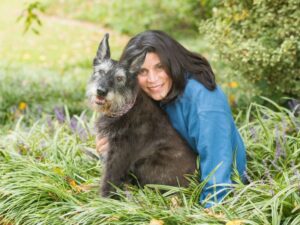
Explore Berger Picard breed insights and hear Jenn Cannon’s views on diversity and unity in the dog community.
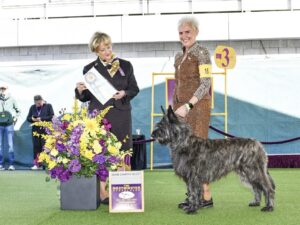
Meet Valerie Black: Breeder of La Vie en Rose Picards. Get insights into the breed, health, and more in this exclusive interview!

Meet Donna Beadle, Eclipse Kennels’ Berger Picard breeder from Minnesota, her famous dogs, and breed insights.
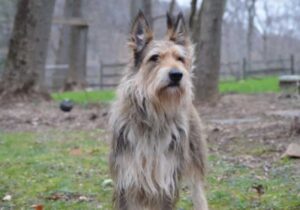
Berger Picard is an athletically built dog with a rustic appearance. The breed is naturally muscular but slim and ready to work all day.
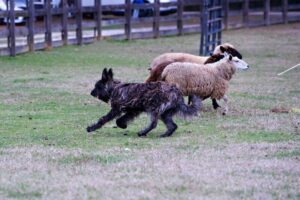
The Berger Picard is a moderate and balanced dog that tended to its flocks of sheep in the areas surrounding its homeland of Picardy, France.
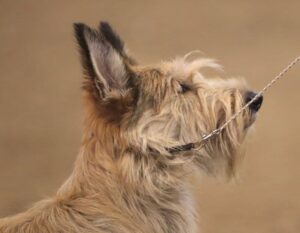
Read on to learn how the Berger Picard breed is judged in the conformation show ring with excerpts from AKC and FCI Breed Standards.
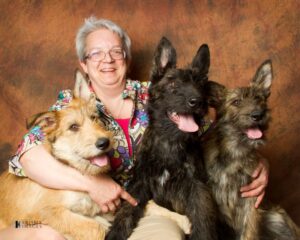
Liz Hansen is the breeder behind Sketchbook Standard Schnauzers & Berger Picards. Read about the kennel’s beginnings, champions, and more!
The best way to ensure a long and happy relationship with a purebred dog is to purchase one from a responsible breeder. Not sure where to begin?
Contact the National Parent Club’s Breeder Referral Program, which is listed on the AKC Breeder Referral Contacts page.
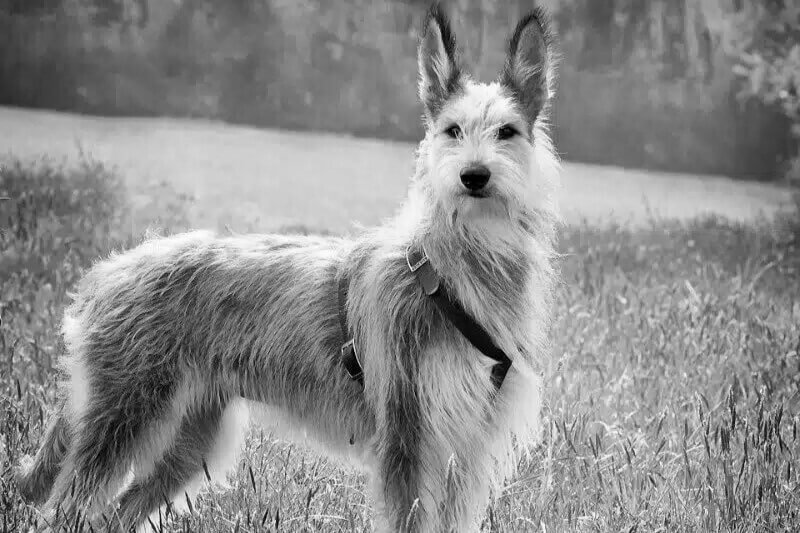

"*" indicates required fields
Showsight Magazine–the world’s most influential purebred dog publication since 1992. Each issue reaches a global audience dedicated to preserving the history and health of purpose bred dogs. Filled with award-winning editorial focused on news and insights from the dog show community, top breeders, handlers, AKC Judges, and more!